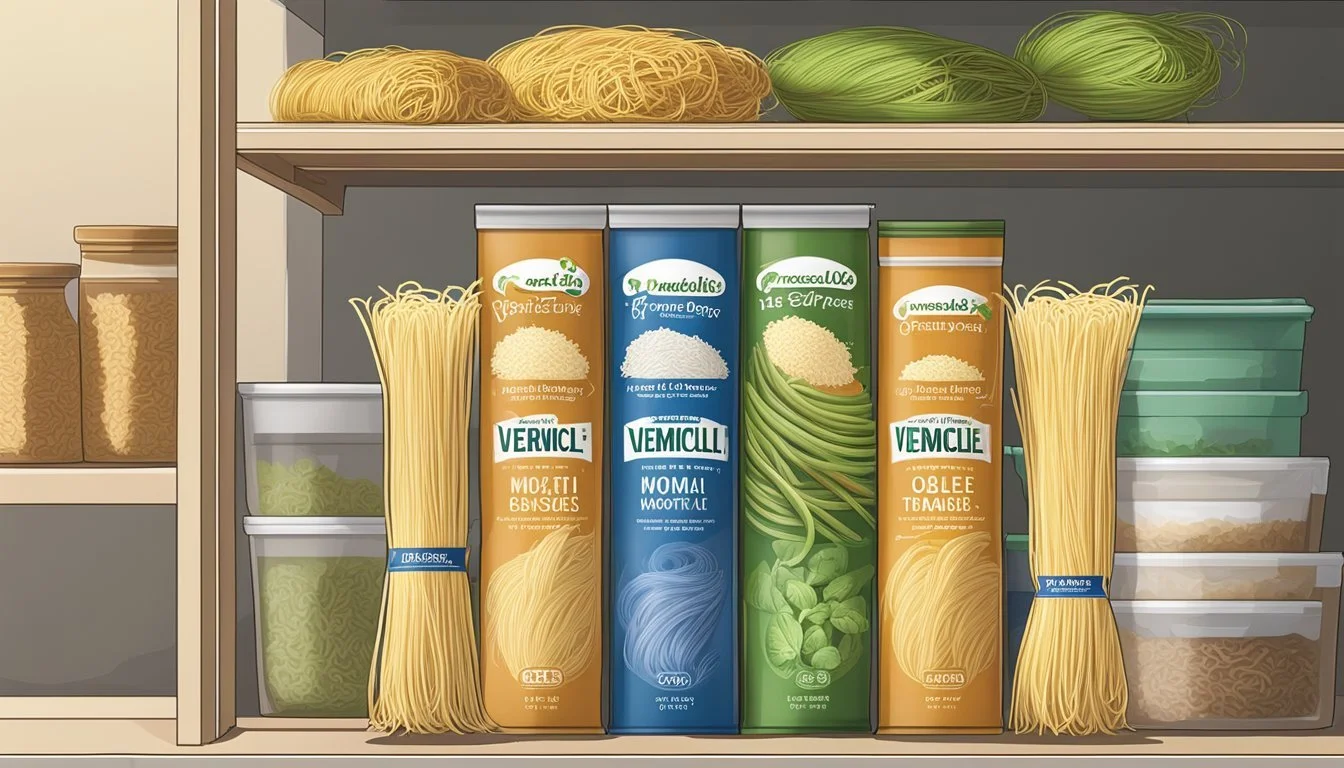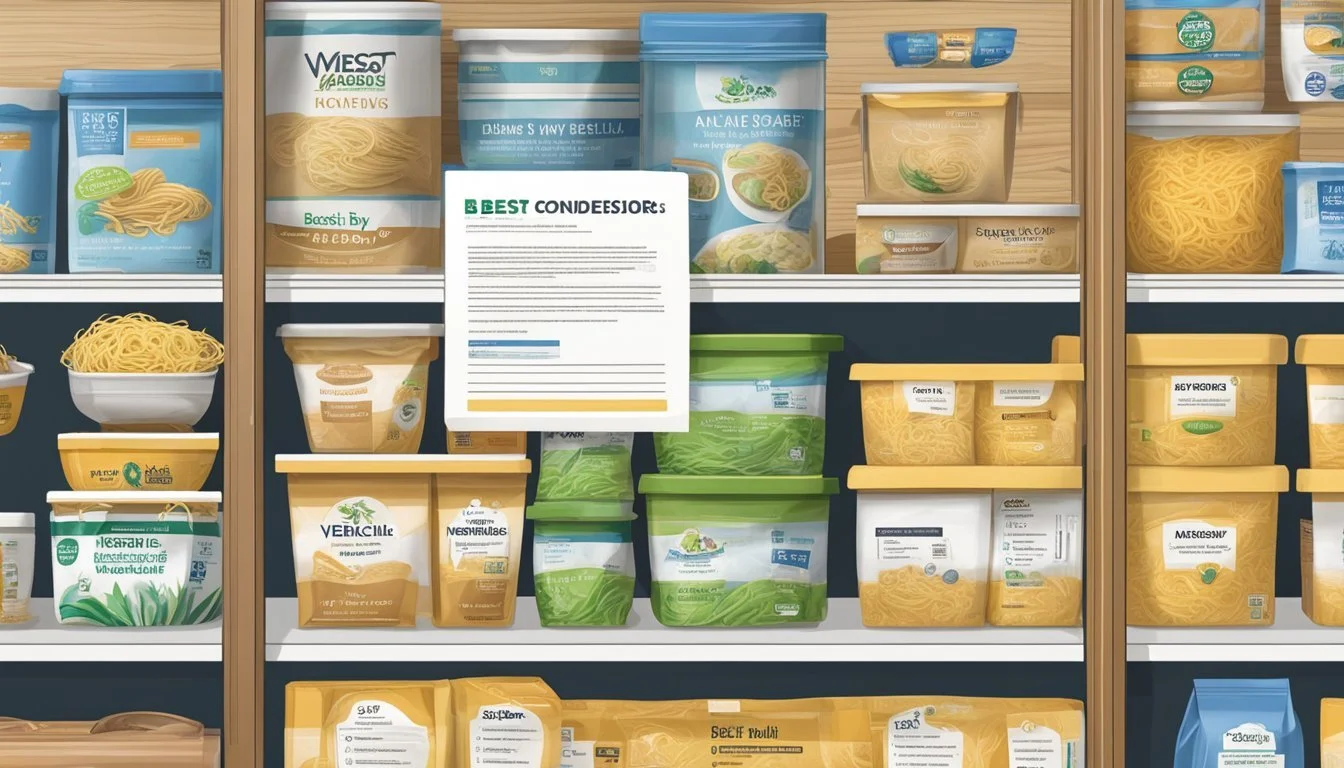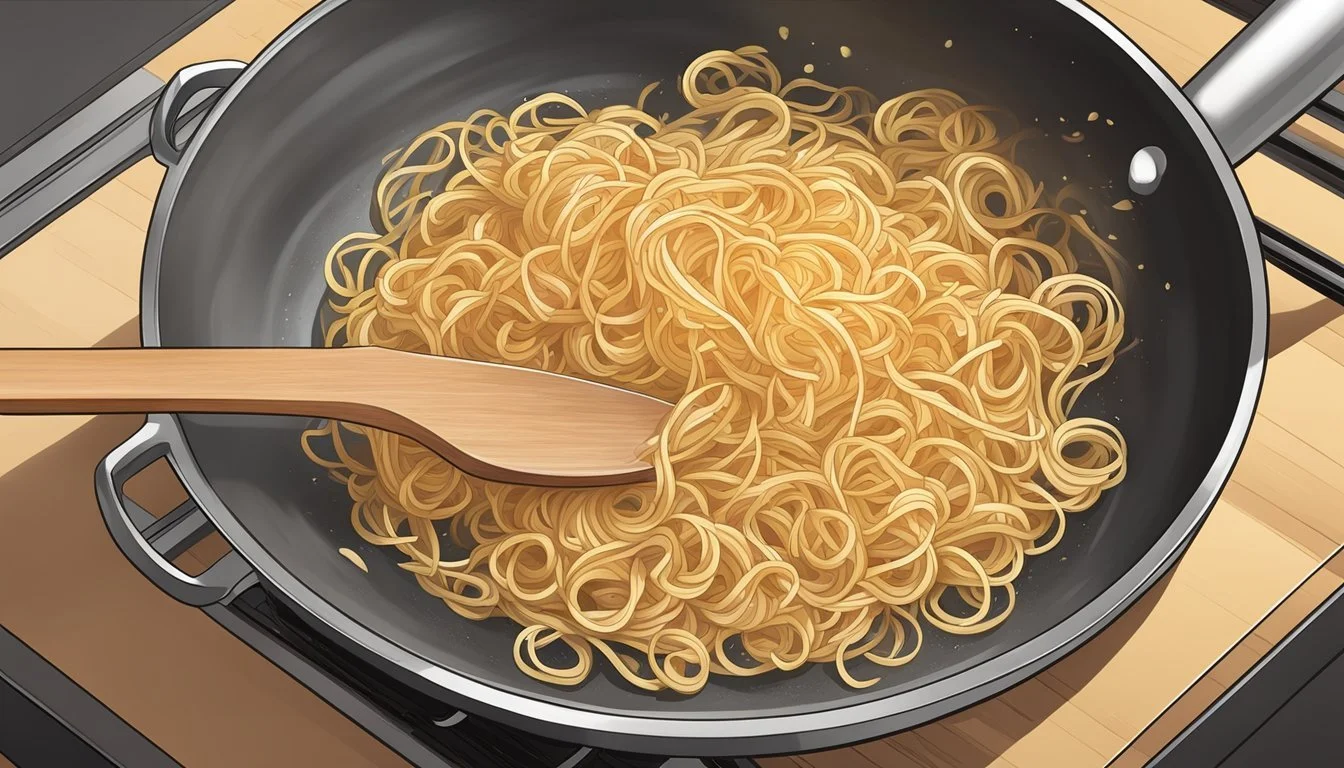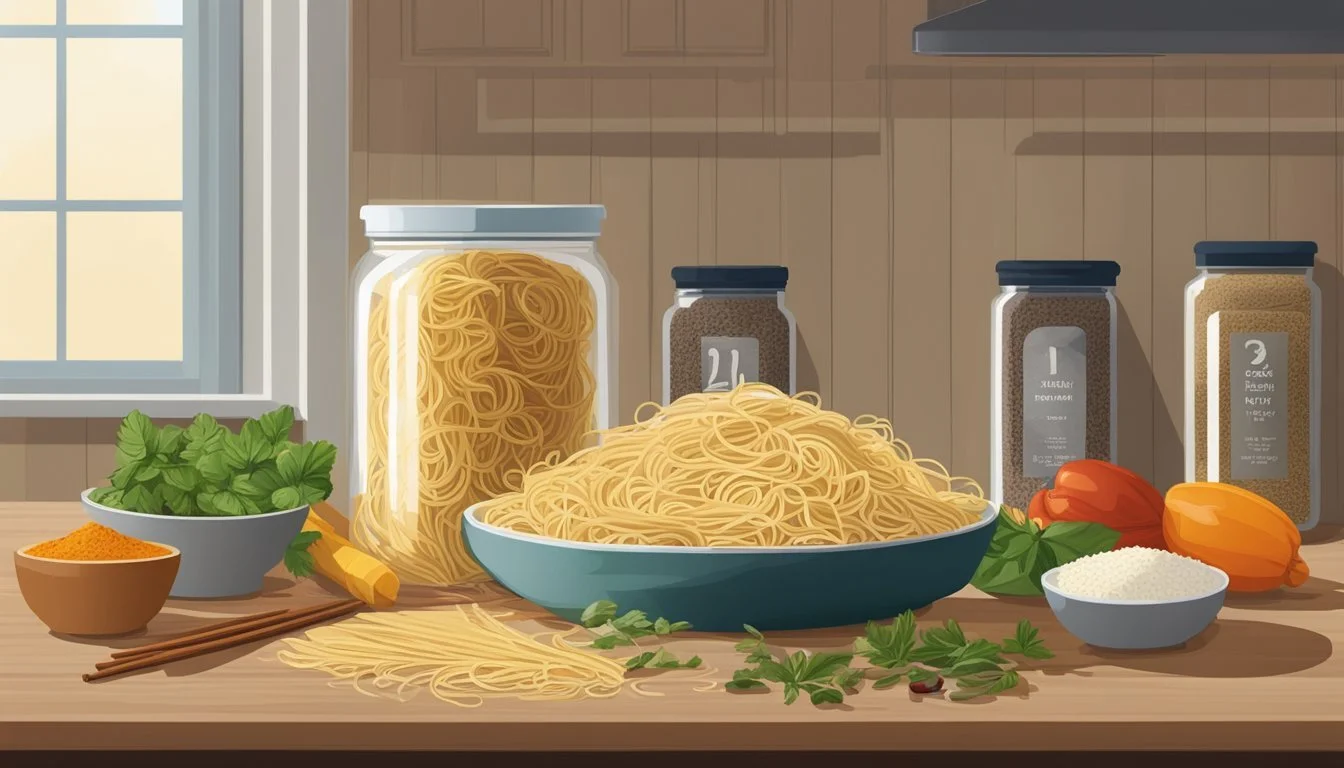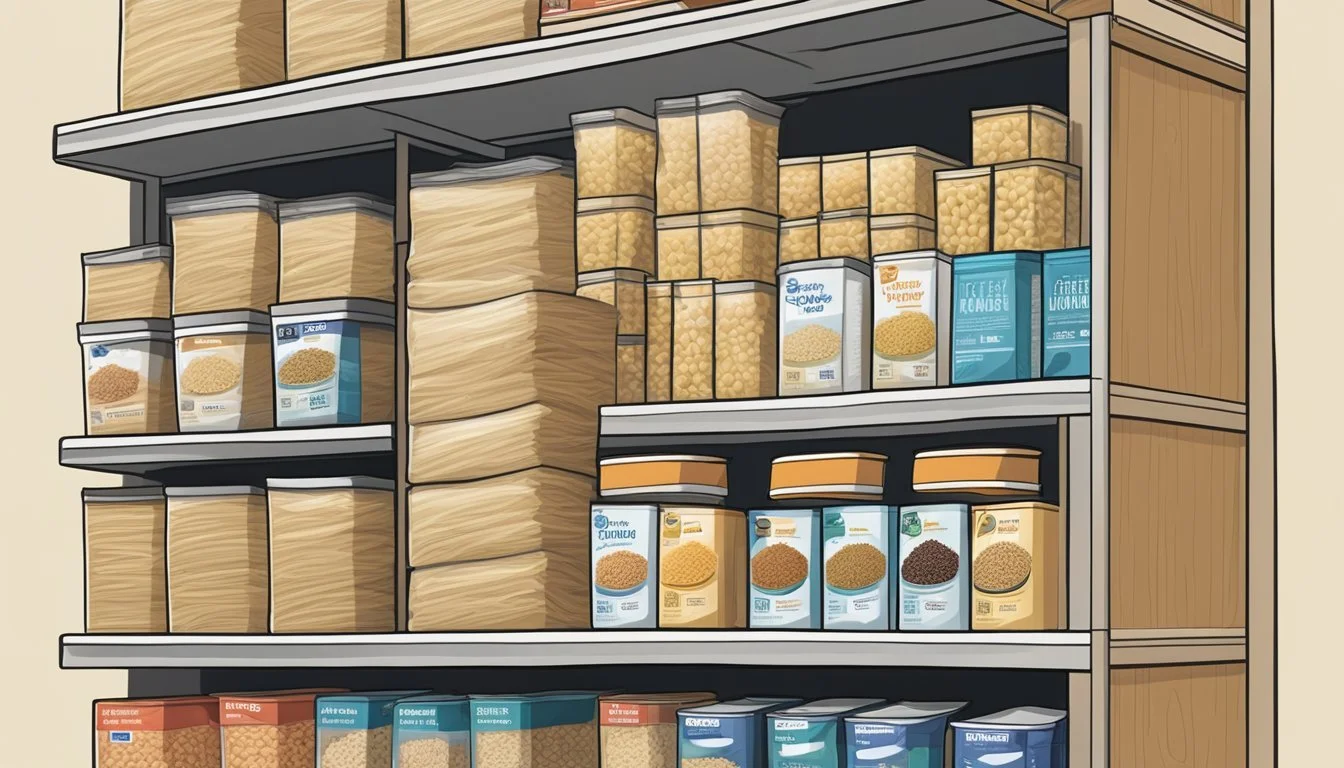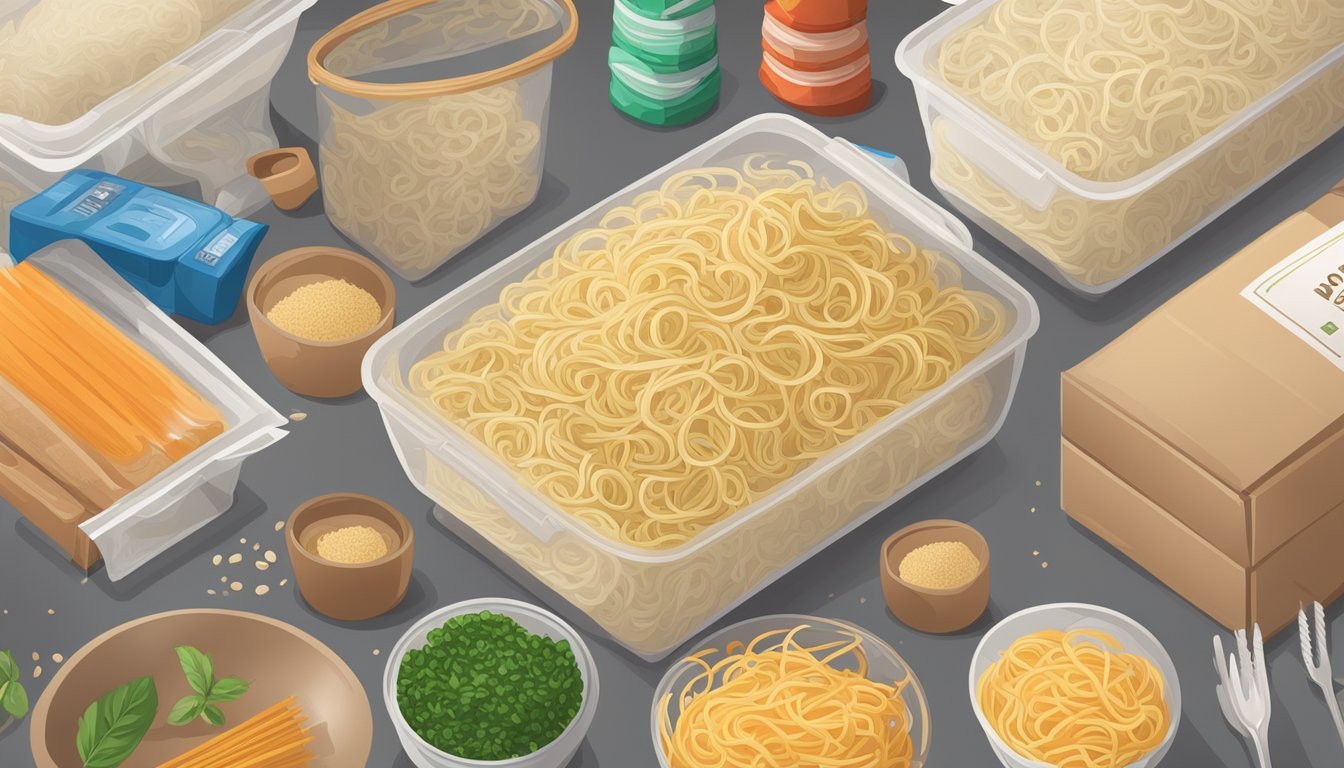How Long Do Vermicelli Noodles Last?
Shelf Life and Storage Tips
Vermicelli noodles (how long do vermicelli noodles last?), whether made from rice or other grains, are a popular ingredient in various culinary traditions, known for their delicate texture and ability to absorb flavors. To maintain the quality of vermicelli, it is crucial to understand its shelf life and the signs of deterioration. Uncooked rice vermicelli typically has a long shelf life when stored properly in a cool, dry place inside a tightly sealed container to prevent exposure to moisture and pests.
Once rice vermicelli noodles are cooked, they become more perishable. To preserve their flavor and texture, cooked noodles should be stored in an airtight container in the refrigerator where they can last for up to four days. Beyond this period, there's a risk that the noodles will lose their distinct quality, as the texture can become mushy and the flavor may start to fade.
The shelf life of vermicelli noodles also depends on the packaging and storage conditions. Unopened, dry vermicelli can last for months, while fresh varieties should be consumed more quickly to enjoy their optimal quality. Observing changes in texture, flavor, or color can help determine if the vermicelli is still suitable for consumption.
Understanding Vermicelli Noodles
Vermicelli noodles are a staple in various cuisines worldwide, offering versatility in both preparation and use. They come in multiple forms, each with distinct nutritional profiles that cater to different dietary needs and culinary applications.
Types of Vermicelli
Vermicelli noodles are primarily made from two types of flour:
Rice Flour Vermicelli: Often found in Asian cooking, these noodles are made from white rice or brown rice flour (how long does rice flour last?). They're recognized for their thin, long strands and are commonly used in dishes like stir-fries, soups, and salads.
Rice Base Characteristics White Rice Flour (how long does white rice flour last?) Light texture, refined, fewer nutrients than brown rice Brown Rice Flour Richer in fiber, stronger flavor, more nutrients
Wheat Flour Vermicelli: Also known as Italian vermicelli, these noodles are thicker than the rice noodle variant and resemble thin spaghetti. They're often used in traditional Italian pasta dishes and are made from refined wheat flour.
Wheat Base Characteristics Wheat Flour Heavier texture, seen in Italian cooking, versatile
Composition and Nutritional Value
Vermicelli noodles' nutritional content varies based on their primary ingredient, whether it is rice or wheat flour:
Rice Flour Vermicelli: These noodles are generally gluten-free and contain carbohydrates as the primary macronutrient. They offer a moderate calorie count and are low in fat.
Nutrient White Rice Vermicelli Brown Rice Vermicelli Carbohydrates High High Fiber Low Higher than white rice Gluten Content None None
Wheat Flour Vermicelli: They are rich in carbohydrates and provide a good energy source. They're not suitable for those on a gluten-free diet but are a traditional component in many pasta recipes.
Nutrient Wheat Flour Vermicelli Carbohydrates High Fiber Varies with processing Gluten Content Present
The choice between rice and wheat vermicelli can influence both the texture and nutritional impact of a dish, making it important for individuals to consider their dietary preferences and restrictions when selecting vermicelli noodles.
Shelf Life Fundamentals
The shelf life of vermicelli noodles depends on whether they are dry and uncooked or have been cooked. Storing them correctly is crucial to maintain quality and ensure safety.
Shelf Life of Uncooked Vermicelli
Dry vermicelli noodles have a shelf life that can extend up to two years when stored in a dry, cool place, away from direct sunlight. The expiration date on the package should be checked to verify they are safe for consumption. To maintain their quality, the noodles must be kept free from moisture, as this can significantly reduce their shelf life.
Shelf Life of Cooked Vermicelli Noodles
Once cooked, vermicelli noodles should be stored in the refrigerator. They maintain their freshness and quality for 3-4 days when placed in an airtight container. If the intention is to keep cooked vermicelli noodles for an extended period, freezing is an option where they can last for up to two months. Cooked noodles should be devoid of any odd odor, which is an indicator of spoilage.
Factors Affecting Shelf Life
Several factors impact the shelf life of vermicelli noodles:
Storage conditions: Dry vermicelli should be kept in a cool, dry place, while cooked noodles require refrigeration.
Packaging: Properly sealed packaging for dry noodles prevents moisture, one of the main culprits for decreased shelf life.
Moisture exposure: Any contact with water or humidity can lead to spoilage of dry noodles.
Temperature: Excessive heat can adversely affect both dry and cooked noodles' shelf life.
Utilizing these storage tips will help ensure that both the fresh, uncooked dry vermicelli and cooked vermicelli noodles remain at optimal quality for consumption within their respective shelf lives.
Proper Storage Techniques
Proper storage of Vermicelli noodles is crucial for maintaining their quality. Understanding the correct methods for dry and cooked Vermicelli as well as freezing techniques will ensure their longevity and freshness.
Storing Dry Vermicelli
Dry Vermicelli should be kept in a cool, dry place such as a pantry. They must be in an airtight container or sealed in a re-sealable plastic bag to protect from moisture and pests. The ideal storage conditions would prevent humidity that could lead to clumping or spoilage.
Storing Cooked Vermicelli
Once cooked, Vermicelli noodles need to be stored in the refrigerator to preserve their texture and prevent bacterial growth. They should be placed in an air-tight container or a zip-lock bag and consumed within three to five days. Ensure they are cooled before refrigerating to prevent moisture buildup which can lead to sogginess.
Freezing and Thawing Vermicelli
For long-term storage, Vermicelli can be frozen. The noodles should be placed in airtight containers or heavy-duty freezer bags. To thaw, transfer the Vermicelli to the refrigerator a day before usage or reheat directly from the freezer. Do note that freezing may alter their texture slightly.
Signs of Spoilage
When assessing vermicelli for spoilage, one must carefully observe changes in appearance and smell or taste, as these can indicate that the noodles are no longer safe to consume and should be discarded.
Appearance Changes
Vermicelli noodles that are spoiled often exhibit visible changes. Consumers should look for:
Color: Noodles that have changed color, such as turning a darker shade or showing discolored spots, may be spoiled.
Texture: Vermicelli should be firm and dry when uncooked. If the noodles appear soggy, mushy, or clump together, they could be bad.
If mold is observed on any part of the vermicelli, this is a clear sign of spoilage, and the noodles must be discarded immediately.
Odor and Flavor Alterations
Any off odors or an unexpected flavor when tasting the cooked vermicelli are strong indications of spoilage.
Smell: A musty, sour, or otherwise off odor emanating from the noodles is a clear warning sign.
Taste: If the vermicelli has an abnormal taste, it's an indicator that the noodles have gone bad or spoiled and should not be consumed.
Safety and Health Considerations
When it comes to vermicelli noodles, safety and health are of paramount importance. One should always be aware of the risks associated with consuming food that has been improperly stored or that has passed its optimal freshness window.
Risks of Consuming Spoiled Vermicelli
Spoiled vermicelli noodles can harbor bacteria that may lead to foodborne illnesses. Consumption of contaminated noodles can result in symptoms such as nausea, vomiting, diarrhea, and abdominal pain. Storing vermicelli properly is crucial to prevent contamination and the growth of harmful microorganisms.
Bacillus cereus is a known bacterium that can contaminate rice and pasta, including vermicelli, and it can survive cooking processes.
Foodborne pathogens like Salmonella or E. coli can also be a concern if the noodles have been cross-contaminated with other foods or if they were handled with poor hygiene practices.
To minimize the risk of consuming spoiled vermicelli, one should:
Store in shallow airtight containers or resealable plastic bags in the refrigerator.
Keep cooked noodles refrigerated for a maximum of 3-4 days.
Freeze cooked noodles if you wish to extend their shelf life, which can keep them safer for a longer period compared to uncooked noodles.
Always check for signs of spoilage, such as changes in texture, color, or smell, before consumption.
Ensure proper hygiene in the kitchen to avoid cross-contamination with other foods or cooking utensils.
Cooking with Vermicelli
Vermicelli noodles are versatile in Asian cuisine and can be incorporated into a range of dishes, from salads and soups to stir-fries. Understanding the right preparation and reheating techniques ensures the noodles contribute texture and flavor to every dish.
Preparation Methods
To cook vermicelli noodles, one typically starts by bringing a large pot of boiling water to a boil. However, for dishes such as Vietnamese vermicelli and spring rolls, noodles can also be prepared without boiling. Instead, they can be soaked in warm water for 5-10 minutes until they become soft and pliable. After soaking, the noodles should be drained and rinsed with cold water to stop the cooking process. This method preserves their delicate texture, making them ideal for incorporation into salads and cold dishes like spring rolls.
For dishes that require further cooking, like pad thai or stir-fries, pre-soaked noodles can be added directly to the pan for the final cook. The key is to prevent the noodles from becoming overly soft or soggy, which would detract from the desired texture present in authentic Asian cuisine.
Reheating Techniques
When reheating vermicelli noodles, the goal is to restore the noodles' temperature without compromising their quality. One can reheat them in a microwave by placing the noodles in a microwave-safe dish and covering them with a damp paper towel. Heat them in short intervals of 20-30 seconds, stirring in between to distribute the heat evenly.
Alternatively, vermicelli can be reheated by plunging them into boiling water for no more than 30 seconds or until they are just warm. This helps to maintain the texture without overcooking the noodles. For stir-fries or soups, adding the noodles at the last minute allows them to reheat in the cooking process and absorb the flavors of the dish.
Maximizing Vermicelli's Freshness and Flavor
To maintain freshness for vermicelli noodles, they should be stored properly in a cool, dry place. If uncooked, vermicelli can be kept in an airtight container to protect it from moisture and other contaminants. Once cooked, vermicelli should be consumed within 2 hours or refrigerated promptly to preserve its quality.
In terms of flavor, the addition of oil, sauce, and seasonings can significantly enhance the taste of vermicelli noodles:
Oil: A light drizzle of oil can prevent the noodles from sticking together. It’s recommended to use a neutral oil that won't overpower the delicate taste of the noodles.
Type of Oil Benefits Olive Oil Offers a slight richness without being too heavy. Sesame Oil (how long does sesame oil last?) Infuses noodles with a nutty flavor, ideal in Asian cuisine. Vegetable Oil Keeps noodles loose and is flavor-neutral.
Sauce: Vermicelli readily absorbs sauces which can deeply influence the overall flavor. Whether one is adding a soy-based sauce, a vinaigrette, or a rich tomato sauce, it should be tossed with the noodles just before serving to ensure they're coated evenly and the flavor is fresh.
Seasonings: Herbs and spices should be added according to the dish's origin. For example, Italian-inspired dishes may call for basil and oregano, while Asian dishes may benefit from ginger and lemongrass. Freshly ground black pepper or a pinch of salt can also draw out the flavors.
To enhance seasoning and sauces, reheating cooked noodles with a splash of water in the pan can revive their texture and better distribute flavors. Always taste and adjust seasonings before serving to ensure the vermicelli noodles are flavorful.
Utilization of Leftover Vermicelli Noodles
When one finds themselves with leftover vermicelli noodles, it's essential to understand proper storage techniques to maximize their shelf life. Vermicelli noodles, after being cooked, should be cooled promptly to halt the cooking process. They should then be stored in the refrigerator within two hours of cooking to maintain safety and quality.
Here's a quick guide on how to store cooked vericelli noodles:
Cool: Allow the noodles to reach room temperature.
Container: Place in airtight containers or heavy-duty plastic bags.
Refrigeration: Store the noodles in the fridge.
Shelf Life: Consume leftover noodles within 3 to 5 days for the best quality.
Reheating the leftover vermicelli requires care. To retain the texture and prevent them from becoming too soft or clumpy, it is recommended to reheat them with a splash of water or broth, either in the microwave or stovetop. For a quick and effortless meal, leftovers can be transformed into stir-fries, salads, or soups.
Stir-fry Idea:
Sauté vegetables of choice.
Add the leftover noodles.
Toss with soy sauce, sesame oil, and your preferred seasonings.
Salad Suggestion:
Toss cold noodles with mixed greens.
Combine with a tangy dressing.
Add herbs and nuts for a crunch.
Mindful handling of leftover vermicelli noodles ensures not just safety and freshness but also opens up a variety of meal options, reducing food waste and providing convenient solutions for subsequent dining experiences.
Innovative Recipes and Pairings
Delicate vermicelli noodles are versatile in the culinary world and can be paired with an array of seasonings and ingredients to enhance flavor while minding sodium levels in dishes. Vermicelli, being thin and light, is an excellent base for a variety of recipes, encouraging culinary innovation.
Refreshing Summer Dish:
For a light summer meal, Lemongrass Chicken with Vermicelli is a perfect pairing. The noodles are complemented by the zesty taste of lemongrass and the nuanced flavors of the accompanying nuoc cham dipping sauce.
Customizable options: Easily adjusted to individual tastes with various herbs and vegetables.
Preparation Tip: To prevent sogginess, noodles should be properly drained and not left in water.
Vegan Delight: A vegan adaptation could involve Tom Yum Fried Vermicelli, elevating the noodles with the tangy and spicy notes of Tom Yum paste. This dish is scrumptious and filling, even for those who may not typically opt for Asian cuisine.
Cooking Time: Approximately 25 minutes.
Note: Fresh or thawed ingredients can be used interchangeably, ensuring they're well-drained to maintain the noodles' texture.
Middle Eastern Fusion: An innovative take might include a Lebanese Rice Pilaf, where vermicelli and rice offer a dual-texture experience, pairing seamlessly with robust Middle Eastern spices and protein-centric dishes.
Texture: Slight nuttiness from the toasted noodles intermingling with fluffy rice grains.
Incorporating these ingredients yields a culinary exploration where vermicelli noodles serve as a canvas for a spectrum of flavors and textures from various cuisines. They act as a testament to the adaptability of this staple ingredient in global kitchens.
Buying and Storage Guide for Vermicelli Noodles
When purchasing vermicelli noodles, consumers should opt for packages without visible damage or moisture, as these factors can affect the quality and shelf life of the product. Dry pasta like vermicelli will have the best longevity when stored properly.
Selecting Vermicelli Noodles
Look for intact packaging: Avoid bags with rips or tears.
Check the expiration date: Ensure it fits within your intended consumption timeframe.
Storage Tips for Dry Vermicelli
Upon bringing dry vermicelli noodles home, one should transfer them to an airtight container and place them in a cool, dry place to maintain their quality. Exposure to heat, moisture, or pests can compromise the texture and taste.
Here's a simple breakdown of the storage methods:
Storage Location Duration Notes Pantry Up to 3 years Cool, dry place Refrigerator Not advised Can cause moisture buildup Freezer Not necessary Not recommended for dry pasta
Storing Cooked Vermicelli
Cooked vermicelli should be cooled quickly, ideally spread on a baking sheet. Then, one can store them in an airtight container or resealable plastic bag in the refrigerator where they will remain good for three to five days.
Key steps for refrigerator storage:
Cool down quickly to prevent bacterial growth.
Use an airtight container to keep out moisture and other contaminants.
Remember, while vermicelli can last for some time, it's optimal to consume them when fresh to enjoy their delicate texture and flavor.
FAQs on Vermicelli Noodle Longevity
How long can one store uncooked vermicelli noodles?
Uncooked vermicelli noodles usually have a shelf life of up to three years when stored properly. They should be kept in a cool, dry place in a tightly sealed package to prevent moisture and air from affecting the quality.
What is the best way to store cooked vermicelli noodles?
Cooked vermicelli noodles can be stored in the refrigerator for 3-4 days. The key is to place them in an airtight container to avoid the absorption of other flavors and odors.
Can cooked vermicelli noodles be frozen?
Yes, to extend the longevity of cooked vermicelli noodles, they can be frozen for up to two months. They should be in a well-sealed container or freezer bag to prevent freezer burn.
How does one reheat vermicelli noodles?
When reheating, one can use the microwave, which is a convenient method. Ensure that noodles are covered to prevent them from drying out and heat them until just warm.
Is there a proper way to thaw vermicelli noodles?
For frozen vermicelli, it's important to thaw them properly to maintain their texture. Thaw them in the refrigerator or at room temperature. Avoid reheating them directly from frozen to prevent them from becoming too soft.
Does refrigerating affect the texture of vermicelli noodles?
Refrigerating may slightly alter the texture of the noodles. When ready to cook or reheat, a quick flash in hot water or a minute in the microwave can help restore their texture.
Conclusion
Vermicelli noodles maintain their quality and freshness when stored correctly. In a cool, dry area, uncooked vermicelli can last up to three years while retaining optimal flavor and texture. For cooked noodles, the window shortens to 2-4 days in the refrigerator. An airtight container is imperative for both uncooked and cooked vermicelli to prevent moisture and odors from affecting the noodles' integrity.
Proper Storage Methods:
Uncooked Vermicelli: Store in a cool, dry place.
Cooked Vermicelli: Refrigerate within two hours of cooking, place in a sealed container.
Freezing: Not recommended for cooked vermicelli as it can alter texture.
The shelf life can also be extended to two months for refrigerated, fresh, uncooked rice noodles (how long do rice noodles last?) if they’re sealed properly. The key to prolonging the life of vermicelli noodles lies in keeping them away from excess moisture and air exposure.
Maintaining the flavor and texture of vermicelli is crucial for delightful culinary experiences. One must ensure that they’re not only stored properly to extend shelf life but also consumed within the recommended time frames to enjoy the noodles’ true essence.


